
Global storm activity of 2008 profiles the major worldwide storms, including blizzards, ice storms, and other winter events, from January 1, 2008 to December 31, 2008. A winter storm is an event in which the dominant varieties of precipitation are forms that only occur at cold temperatures, such as snow or sleet, or a rainstorm where ground temperatures are cold enough to allow ice to form. It may be marked by strong wind, thunder and lightning, heavy precipitation, such as ice, or wind transporting some substance through the atmosphere. Major dust storms, Hurricanes, cyclones, tornados, gales, flooding and rainstorms are also caused by such phenomena to a lesser or greater existent.
Global weather activity of 2007 profiles the major worldwide weather events, including blizzards, ice storms, tornadoes, tropical cyclones, and other weather events, from January 1, 2007, to December 31, 2007. Winter storms are events in which the dominant varieties of precipitation are formed during cold temperatures; they include snow or sleet, or a rainstorm where ground temperatures are cold enough to allow ice, including freezing rain, to form. Thehy may be marked by strong wind, thunder, lightning thunderstorms, heavy precipitation, including ice storm, wind transporting some substance through the atmosphere, including dust storms, snowstorms, and hail storms. Other major non winter events such as large dust storms, hurricanes, cyclones, tornados, gales, flooding, and rainstorms are also caused by such phenomena.

The October 2010 North American storm complex is the name given to a historic extratropical cyclone that impacted North America. The massive storm complex caused a wide range of weather events including a major serial derecho stretching from the Gulf Coast to the Great Lakes, a widespread tornado outbreak across the Southeast United States and Midwest and a blizzard across portions of the Canadian Prairies and the Dakotas. The cyclone's lowest minimum pressure of 955.2 mb (28.21 inHg) made it the second most intense non-tropical system recorded in the continental United States (CONUS). The lowest confirmed pressure for a non-tropical system in the continental United States was set by a January 1913 Atlantic coast storm.

The February 2013 North American blizzard, also known as Winter Storm Nemo and the Blizzard of 2013, was a powerful blizzard that developed from the combination of two areas of low pressure, primarily affecting the Northeastern United States and parts of Canada, causing heavy snowfall and hurricane-force winds. The storm crossed the Atlantic Ocean, affecting Ireland and the United Kingdom. The nor'easter's effects in the United States received a Category 3 rank on the Northeast Snowfall Impact Scale, classifying it as a "Major" Winter Storm.

The 2012–13 North American winter started out somewhat early, as the remnants of Hurricane Sandy brought heavy snow to the mountains of West Virginia in late October. Later, a strong nor'easter affected the weary Northeastern United States, hampering storm recovery efforts and dropping several inches of snow. The rest of the winter featured several other notable events, such as a Christmas winter storm that affected most of the Eastern United States, and the most notable event occurring in early February, when a powerful blizzard struck the Northeast and brought record snow to some areas. During the winter, a weak El Nino was expected to influence weather conditions across the continent.

The 2010–11 North American winter was influenced by an ongoing La Niña, seeing winter storms and very cold temperatures affect a large portion of the Continental United States, even as far south as the Texas Panhandle. Notable events included a major blizzard that struck the Northeastern United States in late December with up to 2 feet (24 in) of snowfall and a significant tornado outbreak on New Year's Eve in the Southern United States. By far the most notable event was a historic blizzard that impacted areas from Oklahoma to Michigan in early February. The blizzard broke numerous snowfall records, and was one of the few winter storms to rank as a Category 5 on the Regional Snowfall Index. In addition, Oklahoma set a statewide low temperature record in February.

The 2016–17 North American winter was quite warm across North America in general, due in part to a weak La Niña that was expected to influence weather conditions across the continent. Several notable events occurred during the season, including a potent winter storm that affected the East Coast of the United States in early January, the second-largest winter tornado outbreak on record later that month, and an unusually warm February. In addition, towards the end of the season, a large cyclonic storm system that caused a large tornado outbreak, flooding, and a potent blizzard occurred in the Heartland of the country. However, the most notable event of the winter was a powerful blizzard that impacted the Northeast and New England in mid-March, towards the end of the season.

The 2017–18 North American winter saw weather patterns across North America that were very active, erratic, and protracted, especially near the end of the season, resulting in widespread snow and cold across the continent during the winter. Significant events included rare snowfall in the South, an outbreak of frigid temperatures that affected the United States during the final week of 2017 and early weeks of January, and a series of strong nor'easters that affected the Northeastern United States during the month of March. In addition, flooding also took place during the month of February in the Central United States. Finally the winter came to a conclusion with a powerful storm system that caused a tornado outbreak and blizzard in mid-April. The most intense event, however, was an extremely powerful cyclonic blizzard that impacted the Northeastern United States in the first week of 2018. Similar to the previous winter, a La Niña was expected to influence the winter weather across North America.
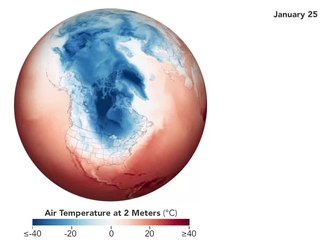
The 2018–19 North American winter was unusually cold within the Northern United States, with frigid temperatures being recorded within the middle of the season. Several notable events occurred, such as a rare snow in the Southeast in December, a strong cold wave and several major winter storms in the Midwest, and upper Northeast and much of Canada in late January and early February, record snowstorms in the Southwest in late February, deadly tornado outbreaks in the Southeast and a historic mid-April blizzard in the Midwest, but the most notable event of the winter was a record-breaking bomb cyclone that affected much of the Central United States and Canada in mid-March. Unlike previous winters, a developing weak El Niño was expected to influence weather patterns across North America. Overall, however, winter of 2018–19 was mild along the mid- and lower parts of the East Coast, the West Coast, and most of the southern Plains. Overall, the meteorological winter of 2018-19 became the wettest on record for the United States.
The January 2019 North American winter storm was a long-lived winter storm, forming as a large area of low pressure off the Pacific Northwest shoreline January 16, making its way to the Northeast by January 21. Its effects included heavy rain/high elevation snow and gusty winds in California, severe weather in the south, near-blizzard conditions in Upstate New York, an ice storm in New England and minor coastal flooding in the Mid-Atlantic.

The 2019–20 North American winter was unusually warm for many parts of the United States; in many areas, neutral ENSO conditions controlled the weather patterns, resulting in the sixth-warmest winter on record, and many areas in the Northeastern United States saw one of the least snowy winters in years. In fact, Baltimore and Islip saw no snow in February for the first time. Some notable events still occurred, such as a powerful blizzard that impacted the Western United States in late November, a series of cold shots in January and February, a snowstorm within the Texas Panhandle and a late-season blizzard in the High Plains.

The November 26 – December 3, 2019 North American blizzard was a major winter storm from the Rocky Mountains to the Northeast as well as a record-breaking windstorm along the West Coast. It occurred the week of American Thanksgiving, hampering travel for millions across the United States.

The 2020–21 North American winter was the most significant winter season to affect North America in several years, and the costliest on record, with a damage total of at least $33.35 billion. The season featured 6 storms ranking on the Regional Snowfall Index scale, with 4 storms ranking as at least a Category 3. Most of the winter's damage and fatalities occurred due to a historic and major cold wave in mid-February. Several other significant events occurred, including a crippling early-season ice storm in the Southern Plains, a powerful nor'easter in mid-December, another major nor'easter in early February, two major and widespread winter storms in mid-February, and a major blizzard in the Rocky Mountains in mid-March. The winter-related events were responsible for at least 358 fatalities, making it the deadliest season since 1992–93. A La Niña pattern influenced much of the winter in North America.

The March 2021 North American blizzard was a record-breaking blizzard in the Rocky Mountains and a significant snowstorm in the Upper Midwest that occurred in mid-March of 2021. It brought Cheyenne, Wyoming their largest two-day snowfall on record, and Denver, Colorado their second-largest March snowfall on record. The storm originated from an extratropical cyclone in the northern Pacific Ocean in early March, arriving on the west coast of the United States by March 10. The storm moved into the Rocky Mountains on Saturday, March 13, dumping up to 2–3 feet (24–36 in) of snow in some areas. It was unofficially given the name Winter Storm Xylia.
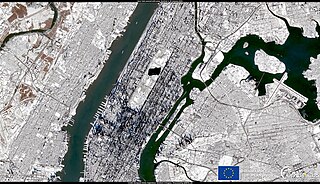
The 2021–22 North American winter was not as significant and record-breaking as the previous winter season. Despite this, several notable and significant events still occurred, including two separate record-breaking tornado outbreaks in mid-December, a significant winter storm in the South in mid-January, a powerful blizzard that impacted the Northeast coast at the end of January and a wide-ranging, significant winter storm that affected most of the eastern half of the country in early February. Additional significant events included a late-season winter storm in March that affected the Appalachian Mountains, and a major blizzard that affected North and South Dakota in mid-April. Additionally, a very late out-of-season snowstorm struck the Rocky Mountains in late May. During the season, four storms have been ranked on the Regional Snowfall Index (RSI), although none attained the “Major” category. Similar to the previous winter, a developing La Niña was expected to influence weather patterns across the continent.
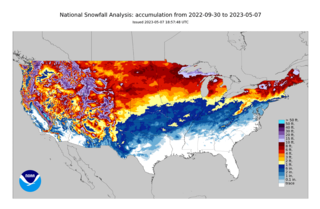
The 2022–23 North American winter was an unusually warm winter for the east and an unusually cold winter for the west in North America, as it occurred across the continent from late 2022 to early 2023. The winter season in North America began at the winter solstice, which occurred on December 21, 2022, and it ended at the March equinox, which occurred on March 20, 2023. The first day of meteorological winter began on December 1 and unofficially ended on February 28; winter storms may still occur outside of these limits.

A winter storm in March 2023 impacted much of the Western, Northern, and Northeastern United States, producing high snowfall totals and widespread damage across the region. The winter storm, unofficially named Winter Storm Sage by The Weather Channel, first progressed across the Western United States as an atmospheric river, and then moved across the northern United States, bringing blizzard conditions and moderate snowfall across the Northern U.S.. The winter storm then became a nor'easter and impacted the Northeast, bringing snowfall rates of 1–2 inches (2.5–5.1 cm) per hour across numerous locations across the Northeast and 3 feet (36 in) of snow in several locations across the region with locally higher amounts. More than 320,000 power outages occurred across the areas impacted by the winter storm, and caused three fatalities and two injuries. Readsboro, Vermont received 42.1 inches (107 cm) of snow, and nearly 200 car accidents occurred across the New England region in the Northeast.
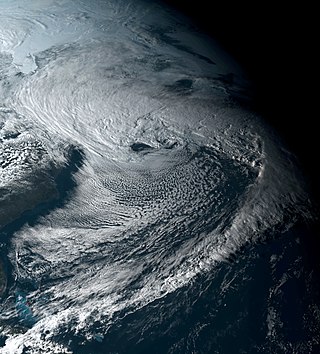
A winter storm, unofficially named Winter Storm Skylar by The Weather Channel, brought widespread blizzard conditions across the Northeastern United States, particularly New England in mid-March 2018. First impacing the Midwestern and Southern United States on March 11–12, causing travel impacts and producing high snowfall totals, the winter storm then moved into the Northeastern United States and became a nor'easter, producing blizzard conditions and heavy snowfall across portions of the interior Northeast on March 13–15. Heavy snow fell in Massachusetts, where most of the state received at least one foot of snow; the storm brought the heaviest March snow on record in Boston and Worcester. Over two feet of snow were reported in portions of Massachusetts, peaking at 31 inches (79 cm) in Wilmington. Heavy snow also fell in Rhode Island, where the snowfall peaked at 25.1 inches (64 cm) in Foster.
The 2023–24 North American winter refers to winter in North America as it is occurring across the continent from late 2023 to early 2024. The season began at the winter solstice, which occurred on December 21, 2023, and will end at the spring equinox on March 19, 2024. Based on the meteorological definition, the first day of winter started on December 1 and the last day will be February 29. However, winter storms may occur outside of these limits.
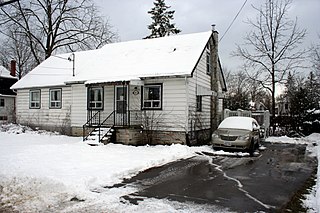
In November 2013, a severe weather outbreak and winter storm, with the latter unofficially named Winter Storm Boreas by The Weather Channel, impacted much of the Western, Southern, and Northeastern United States, as well as southeastern Canada. First impacting the Western United States on November 22 and causing eight deaths, the winter storm then traversed across the South, canceling more than 500 flights at Dallas Fort Worth International Airport and causing a 40-car pileup on Interstate 40 near Vega, Texas, killing 3 people and injuring 11 others. The storm system then moved across the East Coast of the United States, causing a severe weather outbreak which produced seven tornadoes, including an EF2 tornado which injured two people in North Carolina. Strong winds and heavy snow and rainfall occurred across much of the Northeastern United States, with numerous flood warnings being issued and prompting a snow emergency to be issued in western Maryland. Next impacting Canada, the storm system produced heavy snowfall which caused more than 130 vehicle accidents. Overall, the storm system caused 14 deaths, at least 103 injuries, and hundreds of flight cancellations.

















